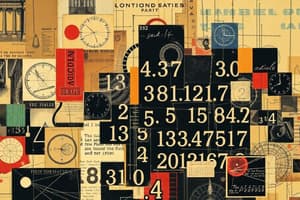Podcast
Questions and Answers
What is the set of numbers that includes rational and irrational numbers?
What is the set of numbers that includes rational and irrational numbers?
- Whole Numbers
- Natural Numbers
- Real Numbers (correct)
- Integers
What type of equation has a graph that is a parabola?
What type of equation has a graph that is a parabola?
- Linear Equation
- System of Equations
- Quadratic Equation (correct)
- Exponential Equation
What is the term for the set of input values for a function?
What is the term for the set of input values for a function?
- Range
- Composition
- Domain (correct)
- Inverse
What type of data is measured in degrees, radians, minutes, and seconds?
What type of data is measured in degrees, radians, minutes, and seconds?
What is the term for the measure of variation that is the average of the squared differences from the mean?
What is the term for the measure of variation that is the average of the squared differences from the mean?
Flashcards are hidden until you start studying
Study Notes
Numbers and Operations
-
Number Systems:
- Natural Numbers (1, 2, 3, ...): positive integers
- Whole Numbers (0, 1, 2, 3, ...): non-negative integers
- Integers (...,-3, -2, -1, 0, 1, 2, 3, ...): positive and negative whole numbers
- Rational Numbers (fractions, decimals, percentages): can be expressed as a/b, where a and b are integers and b ≠ 0
- Irrational Numbers (π, e, √2, ...): cannot be expressed as a simple fraction
- Real Numbers: includes rational and irrational numbers
- Complex Numbers: includes real and imaginary numbers (a + bi, where a and b are real numbers and i is the imaginary unit)
-
Basic Operations:
- Addition (+)
- Subtraction (-)
- Multiplication (×)
- Division (÷)
- Exponents (^)
- Roots (√)
Algebra
-
Equations and Inequalities:
- Linear Equations (ax + by = c): degree 1, graph is a straight line
- Quadratic Equations (ax^2 + bx + c = 0): degree 2, graph is a parabola
- Systems of Equations: multiple equations with multiple variables
- Inequalities: statements with <, >, ≤, ≥, or ≠
-
Functions:
- Domain: set of input values
- Range: set of output values
- Composition: combining functions
- Inverse: reversing the input and output
Geometry
-
Points, Lines, and Planes:
- Points: locations in space, represented by coordinates (x, y, z)
- Lines: sets of points, can be extended infinitely
- Planes: flat surfaces, can be extended infinitely
-
Angles and Measurement:
- Angle: formed by two rays sharing a common endpoint
- Types of Angles: acute, right, obtuse, straight, reflex
- Measurement: degrees, radians, minutes, seconds
Data Analysis and Statistics
-
Data Types:
- Quantitative: numerical data (e.g., height, weight)
- Qualitative: categorical data (e.g., gender, color)
-
Graphs and Charts:
- Types: bar, histogram, box plot, scatter plot, pie chart
- Purpose: visualize and understand data distributions
-
Descriptive Statistics:
- Measures of Central Tendency: mean, median, mode
- Measures of Variation: range, variance, standard deviation
Numbers and Operations
- Natural Numbers are positive integers (1, 2, 3,...)
- Whole Numbers are non-negative integers (0, 1, 2, 3,...)
- Integers include positive and negative whole numbers (...,-3, -2, -1, 0, 1, 2, 3,...)
- Rational Numbers can be expressed as a/b, where a and b are integers and b ≠ 0 (fractions, decimals, percentages)
- Irrational Numbers cannot be expressed as a simple fraction (π, e, √2,...)
- Real Numbers include rational and irrational numbers
- Complex Numbers include real and imaginary numbers (a + bi, where a and b are real numbers and i is the imaginary unit)
- Basic Operations include Addition (+), Subtraction (-), Multiplication (×), Division (÷), Exponents (^), and Roots (√)
Algebra
- Linear Equations are degree 1 and graph as a straight line (ax + by = c)
- Quadratic Equations are degree 2 and graph as a parabola (ax^2 + bx + c = 0)
- Systems of Equations involve multiple equations with multiple variables
- Inequalities are statements with , ≤, ≥, or ≠
- Domain is the set of input values for a function
- Range is the set of output values for a function
- Composition involves combining functions
- Inverse involves reversing the input and output of a function
Geometry
- Points are locations in space, represented by coordinates (x, y, z)
- Lines are sets of points and can be extended infinitely
- Planes are flat surfaces that can be extended infinitely
- Angles are formed by two rays sharing a common endpoint
- Angle types include acute, right, obtuse, straight, and reflex
- Measurement units include degrees, radians, minutes, and seconds
Data Analysis and Statistics
- Quantitative Data is numerical (e.g., height, weight)
- Qualitative Data is categorical (e.g., gender, color)
- Graph types include bar, histogram, box plot, scatter plot, and pie chart
- Graphs are used to visualize and understand data distributions
- Measures of Central Tendency include mean, median, and mode
- Measures of Variation include range, variance, and standard deviation
Studying That Suits You
Use AI to generate personalized quizzes and flashcards to suit your learning preferences.




